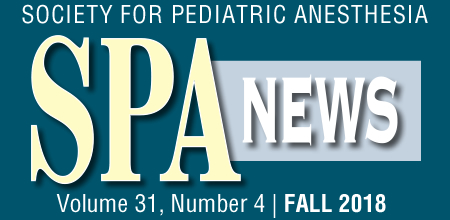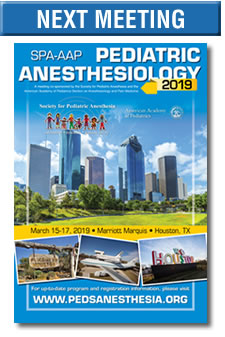meeting reviews
ASA Annual Meeting Session Review
Show Me the Data: Outcomes research in pediatric anesthesia
By David M. Polaner, MD, FAAP
This session, a two-hour panel deftly moderated by Jina Sinskey MD (UCSF), highlighted four large scale multicenter observational projects, three of which are ongoing. It was particularly interesting to note commonalities between them, even though the goals of each project were quite different. Much of the data from these projects have been published and have made significant contributions to the practice of pediatric anesthesia.
After Dr. Sinskey’s introduction, the session began with a description of the Pediatric Regional Anesthesia Network (PRAN), presented by David Polaner MD (Children’s Hospital Colorado), the network’s founding co-chair. He described the project’s origins and growth over its 11-year history to its current status as the largest prospective database of pediatric regional anesthetics in the world, with over 150,000 blocks accrued from more than 20 centers. Important outcomes and findings, such as risk and complication data, the high degree of safety of administering regional blocks in anesthetized children, and a description of the network’s first prospective randomized trial were presented.
Pete Kovatsis, MD (Boston Children’s) presented an overview of the findings from the Pediatric Difficult Intubation Registry (PeDIR). This multicenter prospective observational study has collected highly detailed information on more than 1500 cases of difficult intubation from more than 30 centers and has uncovered several critical commonalities in practice that can lead to increased complication and adverse event rates. Delayed success, hypoxic episodes, and multiple attempts all can occur more frequently when perseveration due to repeated attempts with identical technique or the same operator is permitted, when supplemental oxygen is not administered during intubation attempts, or when fixation bias occurs.
Walid Habre, MD, PhD (Geneva University Hospitals) presented data from the APRICOT study, perhaps the largest and most ambitious project on severe critical events in pediatric anesthesia, as it involved a consortium of 261 hospitals in 33 European countries. Using a novel methodology, data on every anesthetic over a two-week period was collected and analyzed, and severe perioperative events examined. The investigators detected a higher than expected incidence of severe critical events during pediatric anesthetics, along with a high degree of heterogeneity of practice, and recommended that strategies to mitigate and reduce these events be implemented by national and specialist societies.
The final presentation of the panel was given by Manon Hache, MD (Columbia University) on Wake Up Safe, the quality improvement project of the SPA. Somewhat different from the previous studies, Wake Up Safe uses quality improvement methodology and self-reporting from participating centers to learn how adverse events can teach us about the system problems that cause them, and how similitude of events from different institutions can give insight into best practices. Safety advisories have been disseminated to the pediatric community at large as a result of this project, and the participants have advanced practice at their institutions due to their training in QI and patient safety methodology.
The session concluded with a highly illuminating discussion between panelists and the audience that highlighted the great similarities between these different projects, and how the methodological and structural decisions made in the planning stages were critical to their success. All of the panelists emphasized the importance of aggregating data from a multitude of disparate centers to collect meaningful numbers about relatively rare events, and how cooperative ventures like these are essential to understanding the outcomes that arise from our clinical practices.






